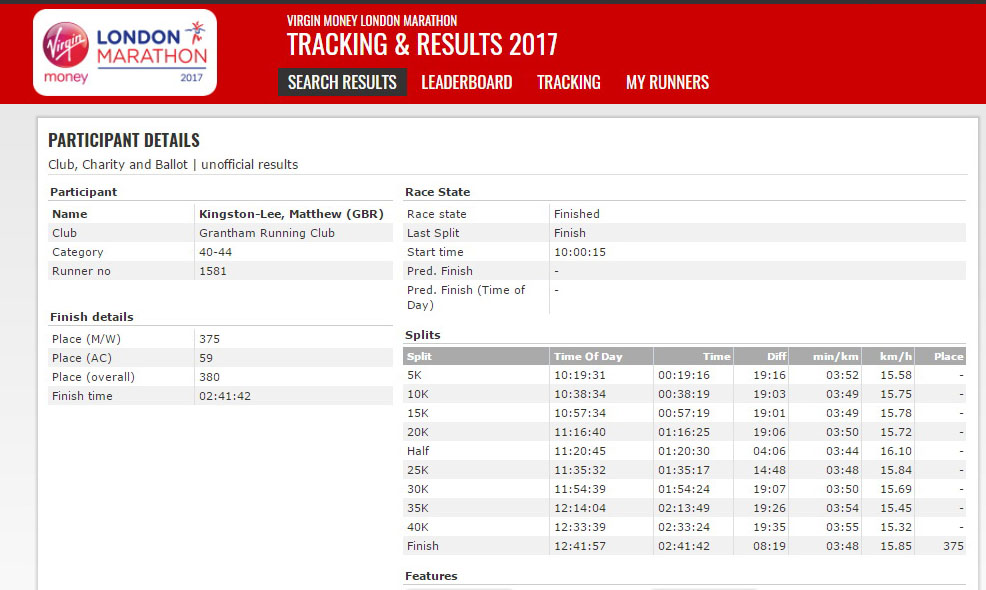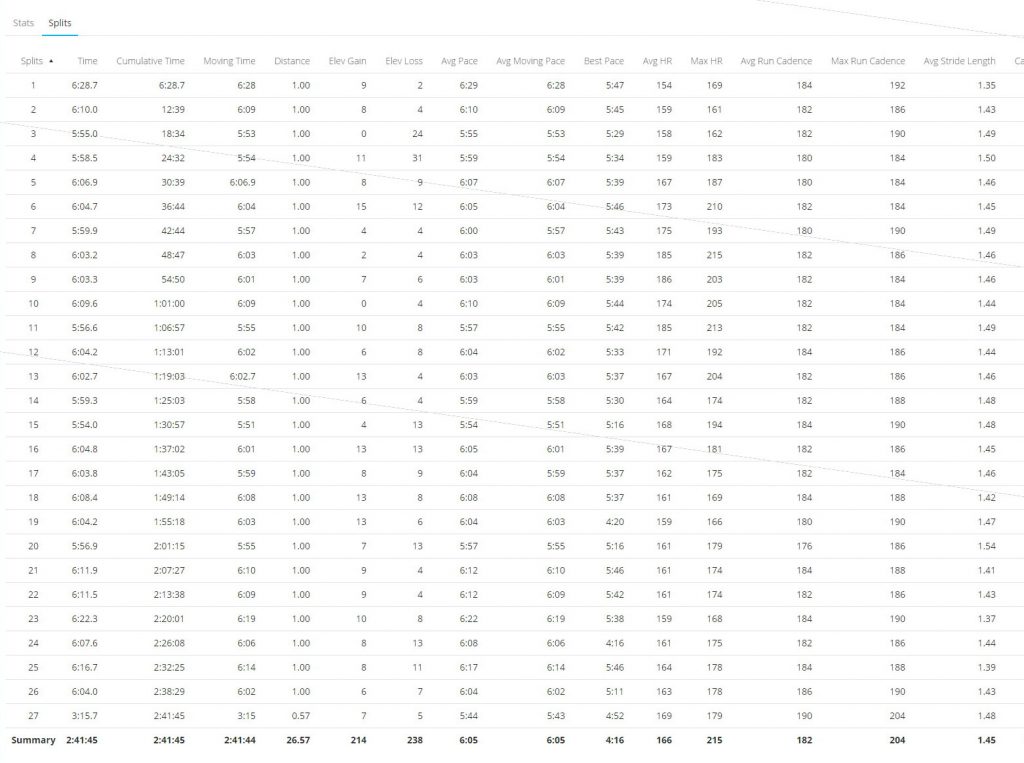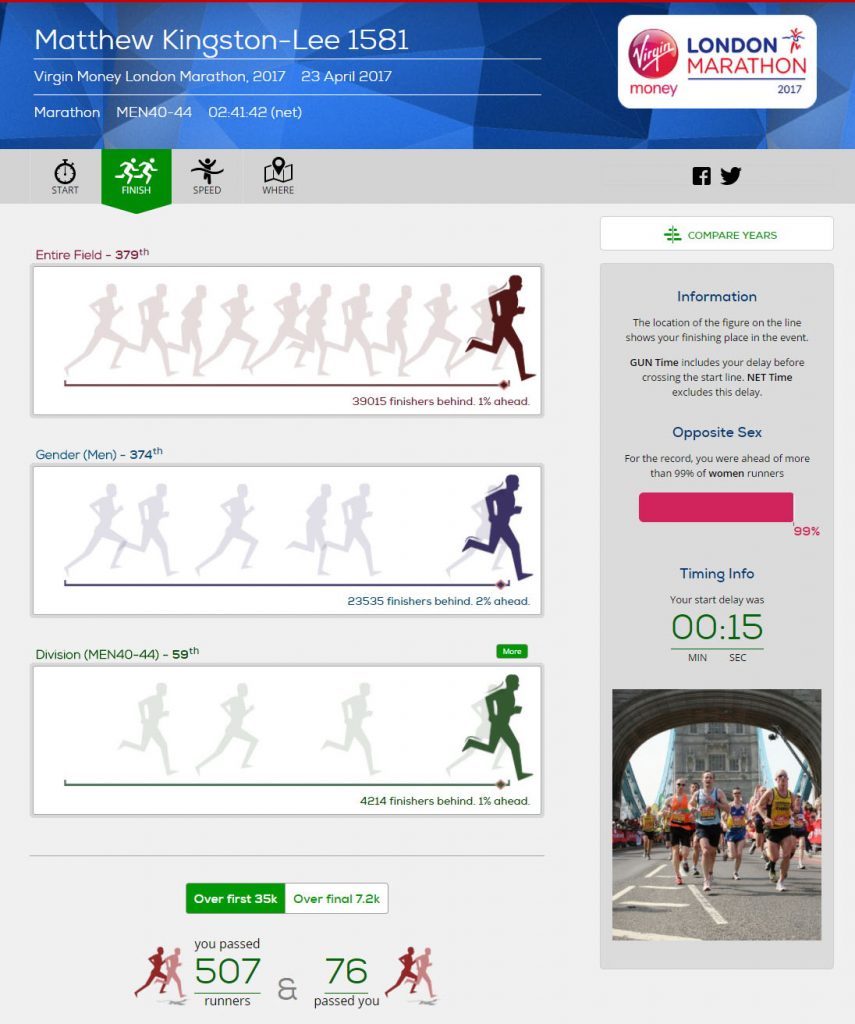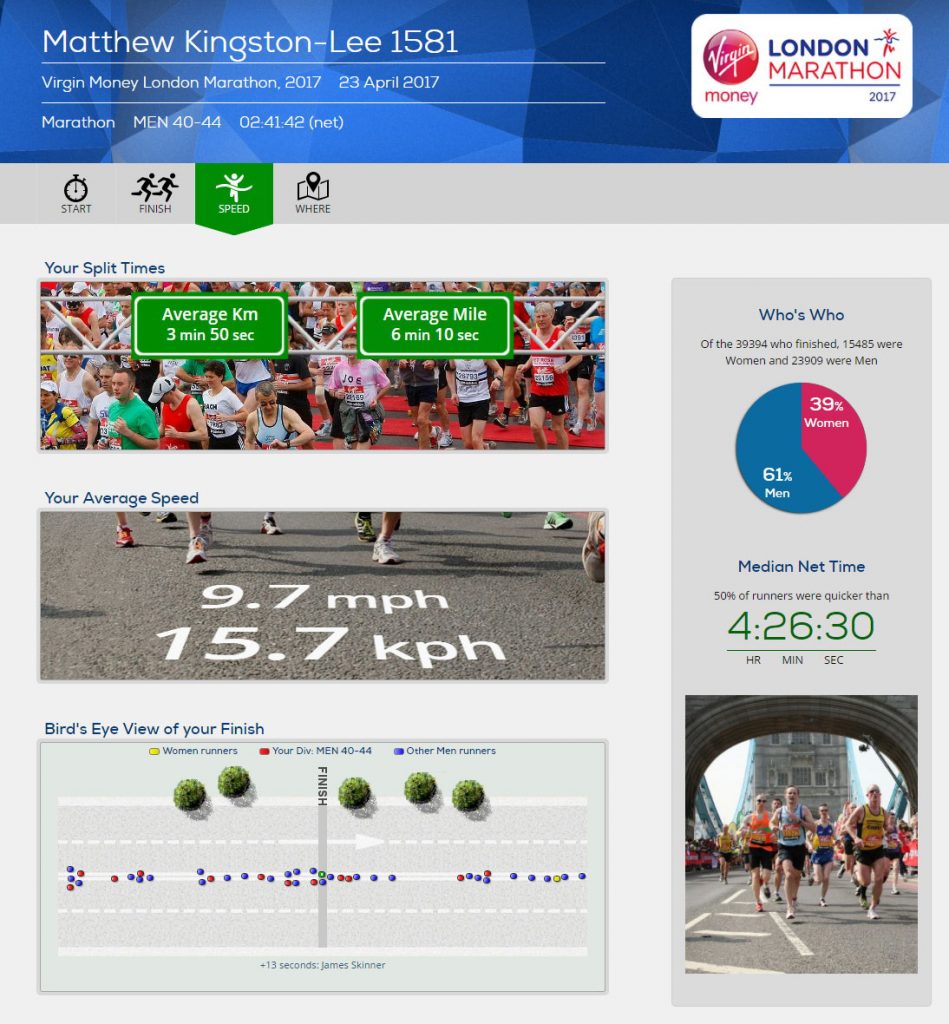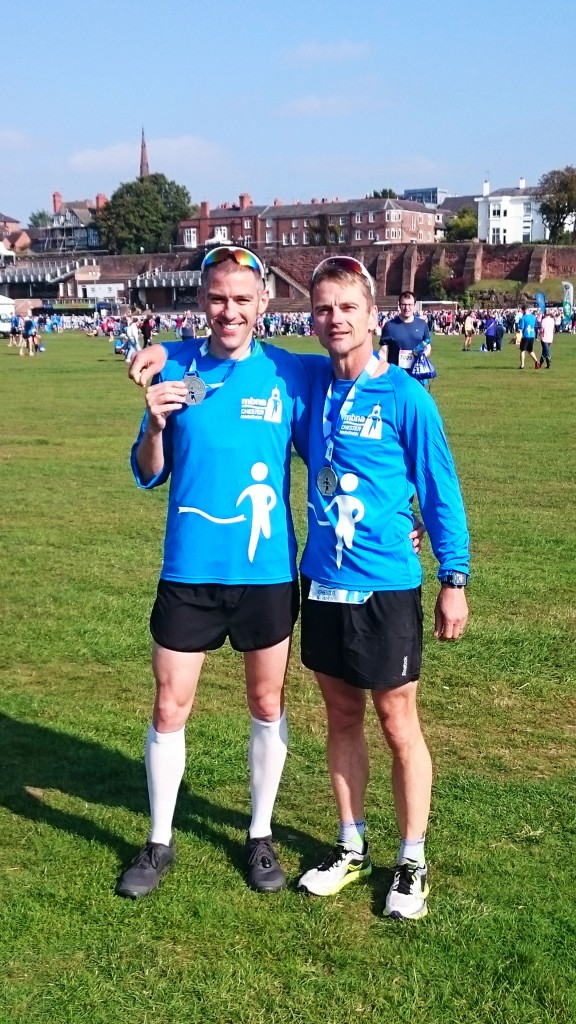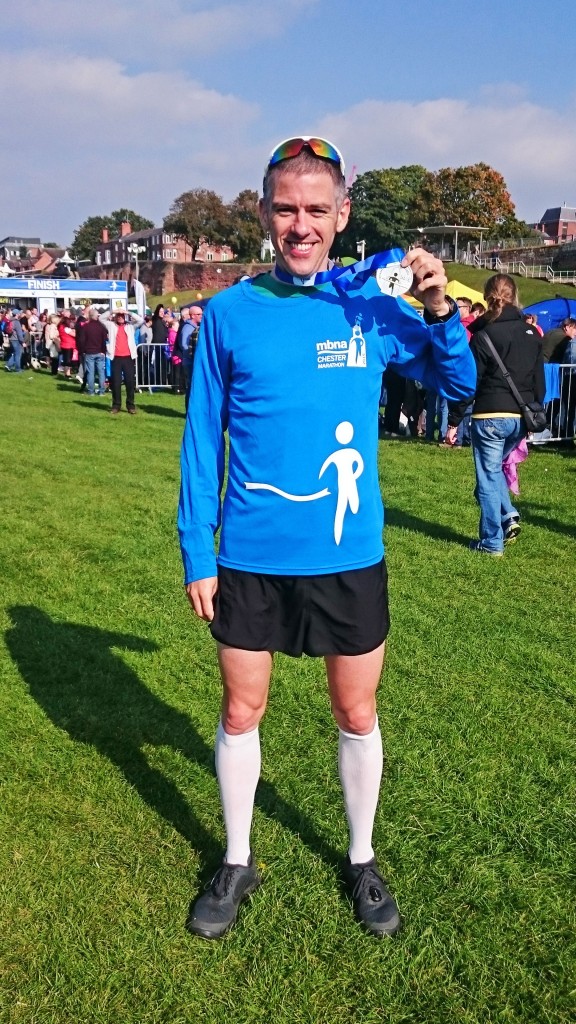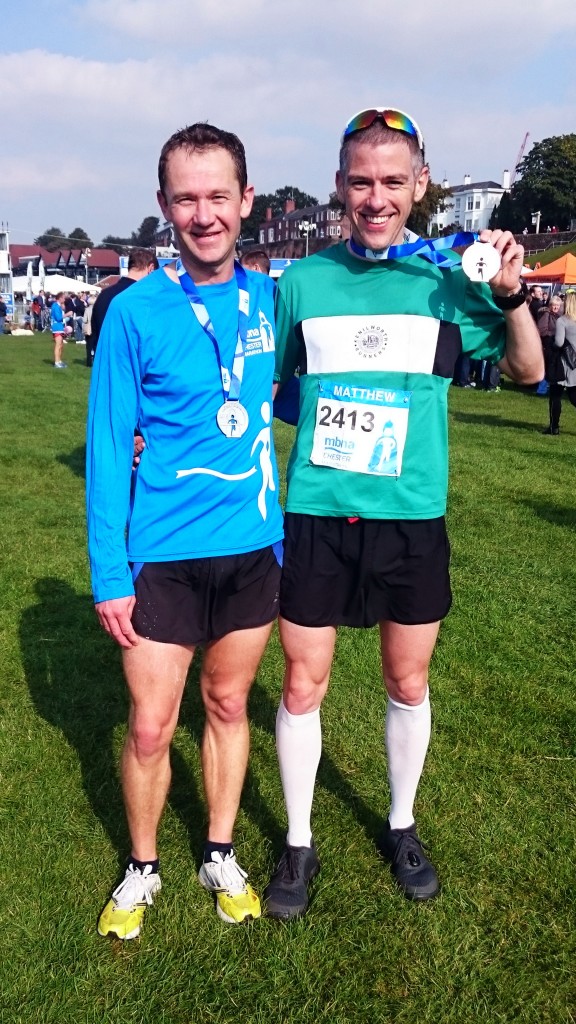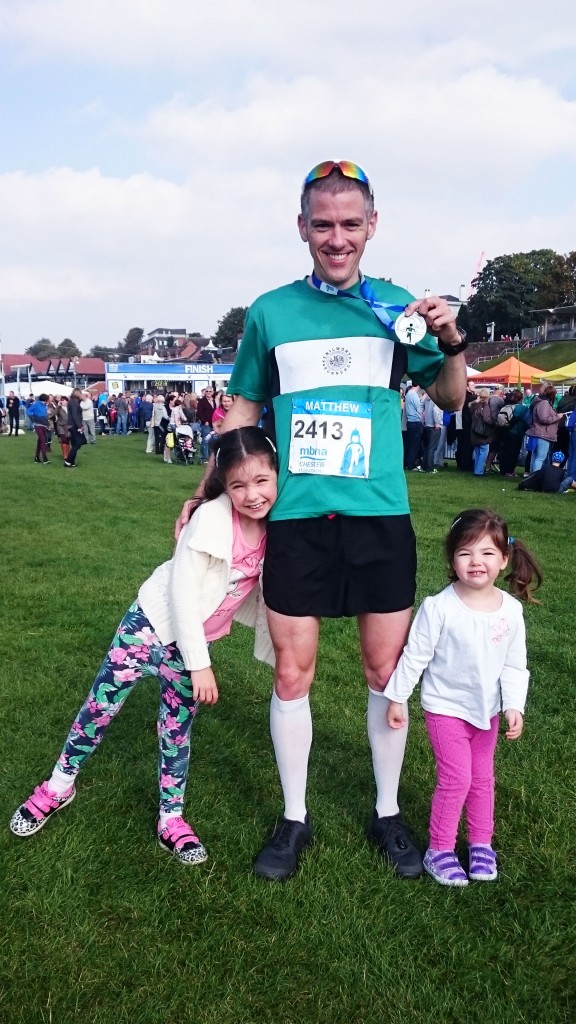Part 1 – The Training
Training for the London Marathon built upon the structure laid down for the 2016 race, which I felt was highly successful, even if illness and some injury issues culminated in a sub-optimal race performance. As with that effort and efforts of recent years, there was no rigid plan laid out, just a few key sessions that I tried to perform every week.
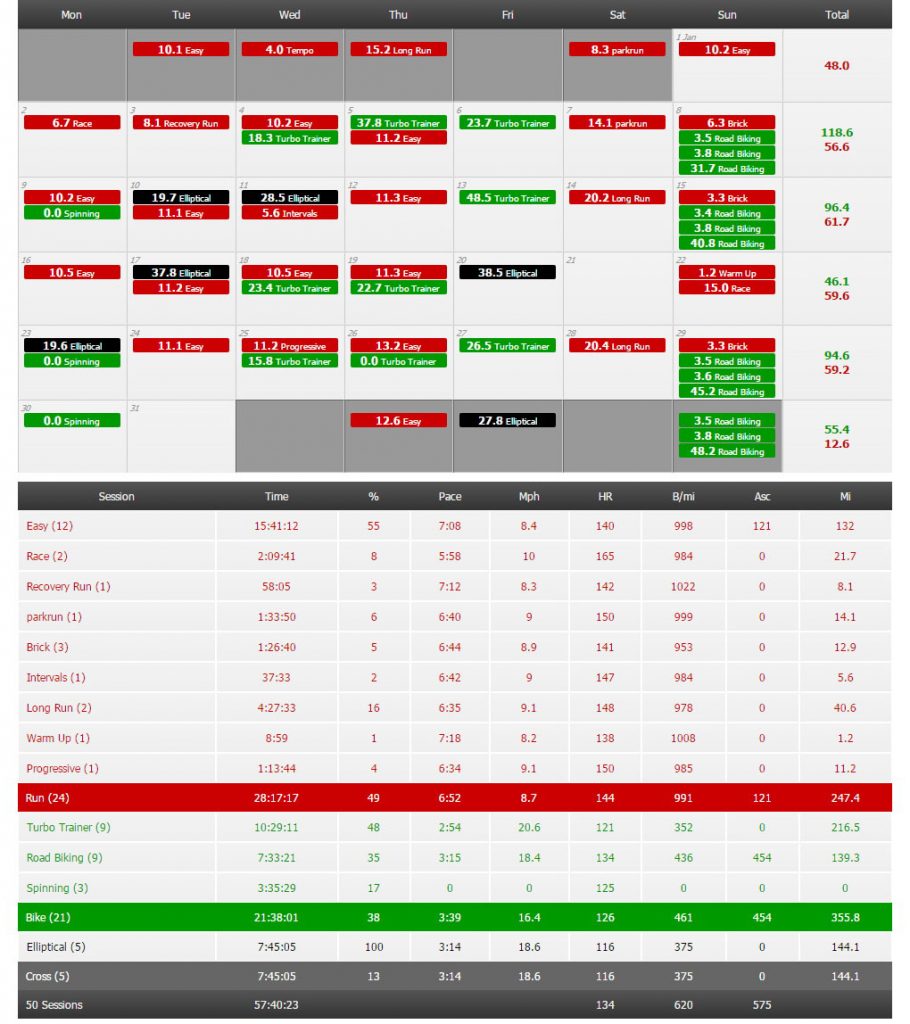
January was a month with base building in mind up to the Folksworth 15 on January 22nd.
not just for running but for cycling too – the Clumber Park Duathlon in March an event I was not training specifically for, but definitely had on my mind. Actually the only session missing from this month compared to later months was the lack of a marathon paced run. These are one of the two key run sessions in my weekly training – the other being the Long Run. These began in February starting with four miles at marathon pace or heart rate, depending on how I felt, and increasing week by week until I was running 8-9 miles at marathon pace in a run varying between 11-16 miles.
A difference from previous years is that the long run was long pretty much from the start of the year. Another feature of the long run was that it was always on the Saturday (I cycled on the Sunday) and it incorporated a parkrun at some point in the run at pace. I’d tinkered with this in 2015 and early 2016, but made it a regular event in late 2016 and decided to carry it through into my marathon training. The first long run in January had 8 miles, then parkrun and a three mile jog home.
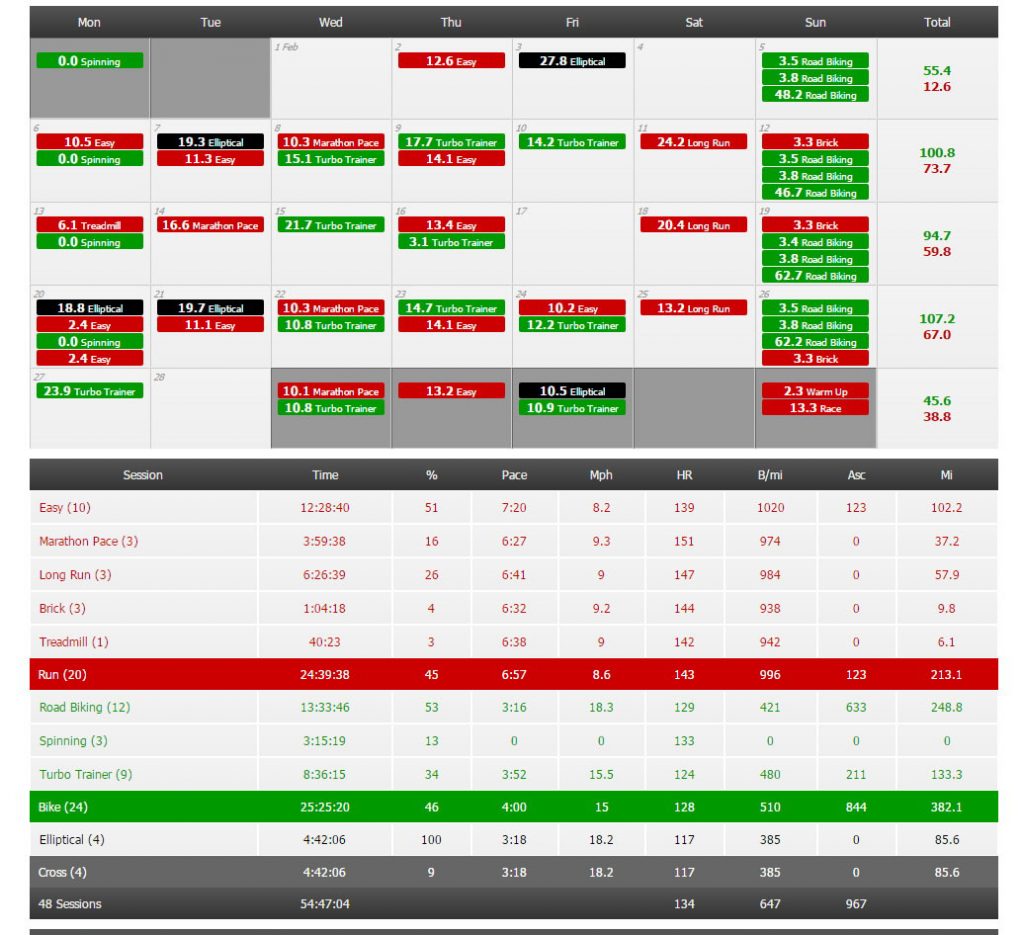
By the second week of February this had increased to 13 miles, then parkrun, then eight miles to finish. This was unusually early for what is usually my longest distance when marathon training. I trumped that a month later in March when I ran 14.5 miles, then parkrun in 18:02, and then eight miles to make up a 26.6 mile run. This is the first time in training I’ve ever run the marathon (Slightly more than, mirroring the likely finishing distance on my Garmin down in London on April 23rd) distance and moreover the time taken to run a marathon was 2:51! This gave me great confidence going forward as the run felt very comfortable – I could have gone much faster if needed. Following that effort I ran twice more in excess of twenty miles – an equally important run was the last twenty miler in early April, which was 10 miles, then the Grantham Cup (a hilly, off road 10K – where I finished 6th) and a four mile jog to conclude.
In total I ran 10 ‘Long Runs’ (Runs I marked as Long on my training log) totaling 200.5 miles at an average pace of 6:40. There were numerous runs of 12-16 miles that I didn’t classify as long runs as I had run longer elsewhere in the week. Suffice to say I really rate the long run with the fast parkrun thrown in at some point.
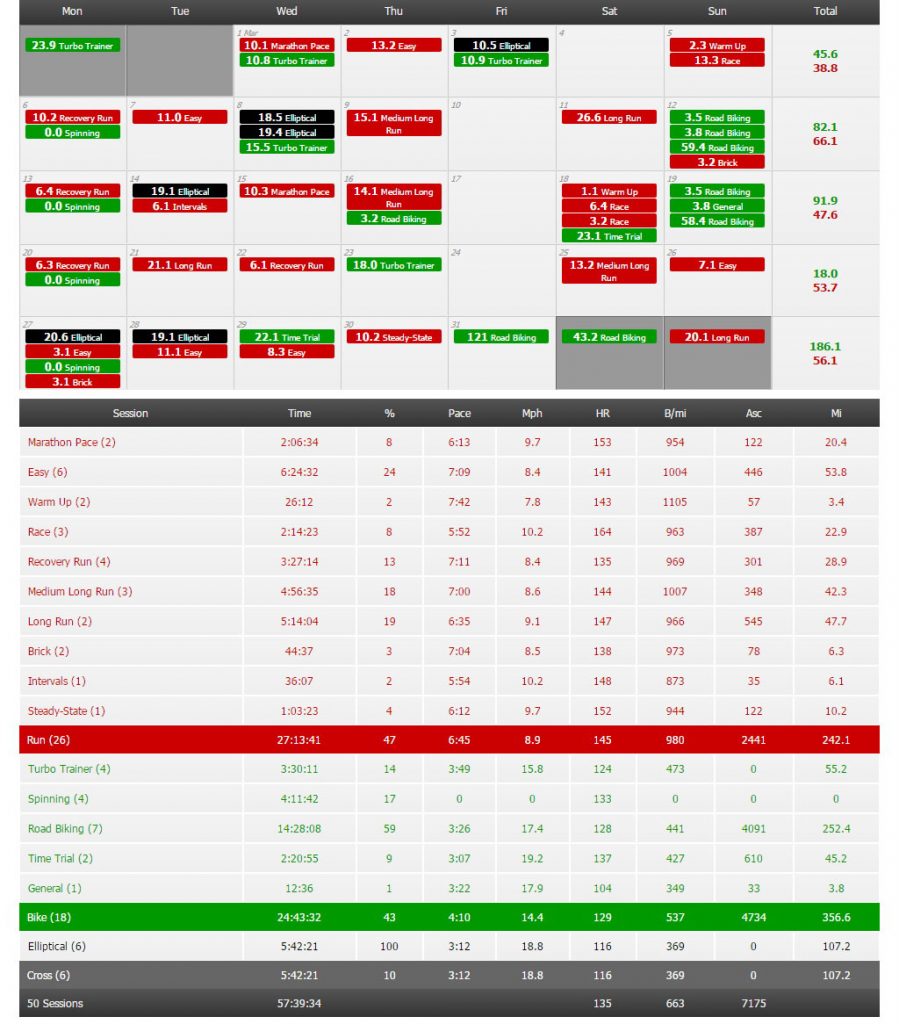
There were no two weeks that were identical in layout, but roughly a week’s training looked a little like this:
Monday: An easy paced run in the morning (typically 10k or 10 miles) with a spinning session in the evening. When the clocks went forward I jogged to and from the spinning session (10K).
Tuesday: Most weeks I spent an hour or perhaps two on the elliptical trainer, followed by 11 easy miles in the evening while my daughter was at Brownies. Once I did a long run in the morning. There was one intervals session in March (The one and only during my marathon training) and in April I began time trialing (cycling) again in the evening.
Wednesday: The morning was usually when I ran my marathon paced run – typically 10-12 miles. In the evening I was on my Turbo Trainer. Most efforts were easy and no more than an hour.
Thursday: Most evenings saw me take a marathon paced session for Grantham Running Club, where we’d run anything from 3-8 miles usually at between 7-7:30 pace. Overall distance for myself was anything between 11-15 miles. Quite a lot of weeks saw me on the Turbo Trainer in the morning.
Friday: Most Fridays in January and February either saw me on the elliptical trainer or on the Turbo Trainer. I ran once and in late March I did a 118 mile very hilly cycle ride in anticipation of the upcoming Fred Whitton bike ride. In March and April, Fridays frequently became a rest day.
Saturday: This was usually long run day – usually with a parkrun thrown in.
Sunday: Most Sundays up to the middle of March saw me take part in the Witham Wheelers Reliability rides, which began at 32 miles and peaked at 68. I made a point of running a 5k brick after the ride. Once these ended I ran on a Sunday.
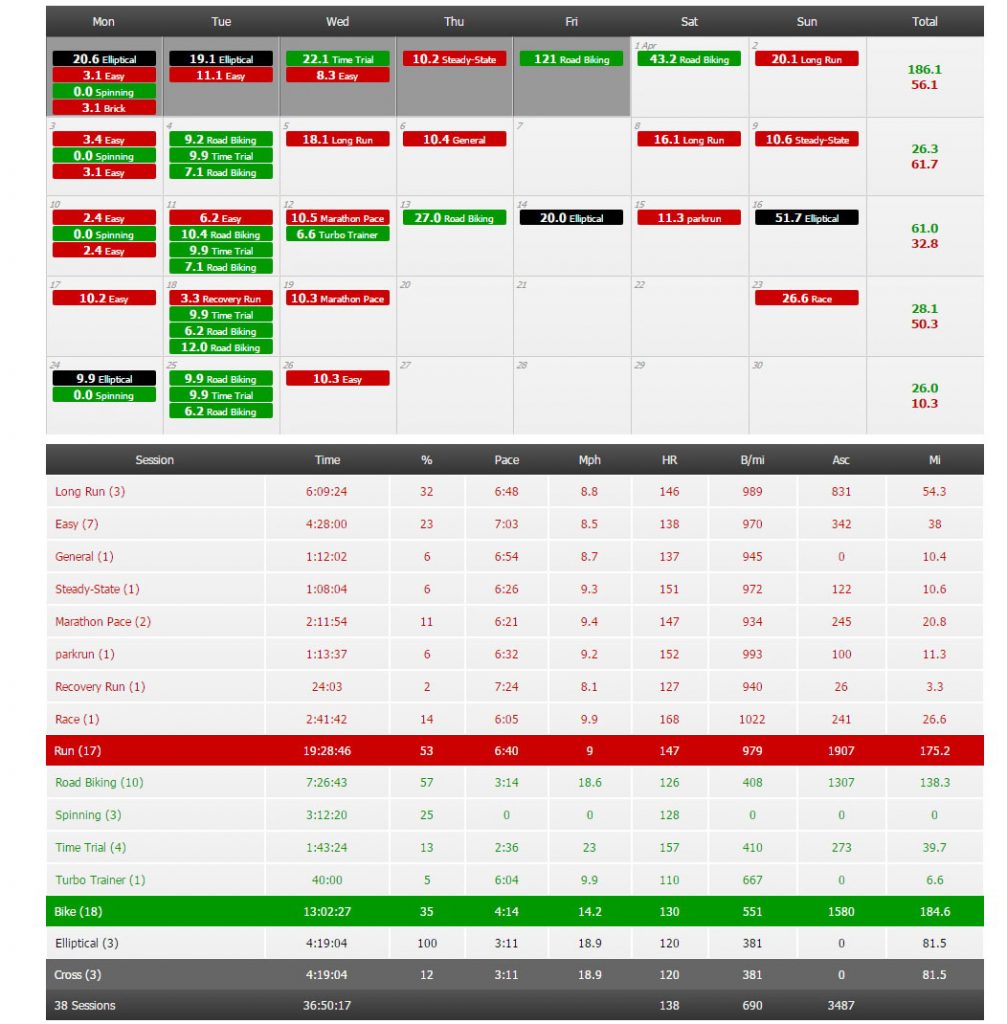
The taper began two weeks out. I kept the intensity of effort fairly high but gradually reduced the volume. The Saturday before (eight days out) I headed to Beeston to run 11 miles with a quick parkrun after 3 miles. warm up. The Sunday was a little unusual as I went on the elliptical trainer for 2 hours 40 minutes – a kind of marathon simulation if you like, but relatively easy on the legs. This had the effort of making the legs quite sore for a few days, but I still put in a 90% intensity TT on the Tuesday and then a 10 mile run on the Wednesday with 5k at marathon HR. The 5k was 17:35 which proved to me at least that I was peaking at just the right moment.
Reverting to my old ways, I decided after that effort to take three days of complete rest, save the school runs and a fair amount of stretching and strength work. Mentally this was quite hard but I think my body enjoyed the rest! By Saturday I was chomping at the bit to get out running.
I raced three times before the marathon – the Folksworth 15 in January (7th, 1:28:23), the Newton’s Fraction Half Marathon (4th – 1:18:01) and the Grantham Cup 10K (6th 40:34) There was also the Clumber Park Standard Distance Duathlon where I finished third in my Age Group, qualifying for the 2017 European Duathlon Championships.
Some things worth noting: I used the elliptical trainer a lot less than I did for training in 2016, but I did compensate somewhat by using the turbo training a fair amount compared to not at all during the marathon training of 2016.
Apart from a half-gas club pyramid session in early January and a more concerted 10×2 minutes effort in late March, there were no interval, rep, or hill sessions.
Injury wise I was very fortunate – I don’t recall having to miss nor compromise a session due to injury, whereas in 2016 I spent a good deal of the time battling niggles. However, while I didn’t suffer injury, I was plagued with colds mostly brought home by my daughter who began nursery. I reckon there was only a week in total up to around mid February where I wasn’t either suffering from a cold or feeling run down from having had a cold. This was shown starkly on the bike and elliptical trainer, where power was measurably down on previous years, and running, where I felt I was unable to maintain pace when the HR climbed high. I knew that the fitness was there though, as on the days when I was illness free, the expected watts and pace was present and correct.
There was also a suspicion at times that I was over training, which is one of the main reasons why I opted to tone down the volume of elliptical trainer sessions in particular. This meant that perhaps more than ever the emphasis was on quality rather than quantity, although there was still a fair amount of quantity and not a lot of rest days in the build up.
Part 2 – To The Start
The conclusion to my taper was three days of rest. I stretched, massaged, tried to do as little as possible. Many things remained constant to previous marathons – pasta on the Thursday and Friday; pizza the night before. I had contemplated doing the old school carb depletion but thought better of it in the end having read about how horrible it can be and no definitive consensus on whether it works. I headed to bed shortly after ten pm with a 5 am wake up call to look forward to. My wife, suffering a heavy cold along with my two daughters, generously offered to sleep in another bedroom to minimise the chance of infection and so I didn’t have to hear her coughing through the night. This martyr like behaviour paid dividends as mercifully I was asleep within minutes and I slept well – perhaps a little too well.
I woke wondering what on earth I was doing waking at 5 am before coming to my senses and remembering I had a marathon to run. I made those first tentative steps out of bed (I’m getting old, I always creak a little these days on waking up). All was well except a little tightness in the right hip – tightness I’d not been aware of in the whole of my marathon training. I put it down to having perhaps slept in a slightly odd position and tried not to think too much of it.
I made myself a strong coffee and changed into my Skins A400 compression shorts and 2XU calf sleeves. Since the bitterly cold Newton’s Fraction Half Marathon, where my quads especially suffered, I’d invested in some quality compression half tights. I first wore them for my 26.6 mile training run and loved the feeling they gave – very similar to the brick runs I often do in my cycling shorts. I find the compression in the quads somehow makes me run faster or at least give the impression of running faster. I’ve worn them numerous times and despite learning a painful lesson that some kind of wicking underwear is strongly advised on warm days – I chafed where no man wants to chafe – they have now become my turn to shorts for hard training sessions and races, so much so I have invested in four (heavily discounted) pairs of them.
I left Grantham by car with my wife and my eldest daughter at 5:45. I had planned originally to leave at 6 am but my wife looked at the train time table and noticed that the 7:20 or so train I thought I’d caught in previous years was now either a 7:03 or a 7:39 – much later than I thought it was. So I made good use of the near empty A1 to safely drive to Stevenage station with a few minutes to spare to catch the 7:03 to Kings Cross, bidding farewell to my wife who drove off to park the car.
Ticket bought I went down to platform 6 as the departures board suggested to catch the train. I noticed the platform was empty; platform 1 had a reasonable volume of nervous looking folk carrying the same Marathon baggage bags I had, so I assumed there had been a platform change. So I ran up the platform stairs, over the concourse and down to platform 1 where I heard the tannoy announcement, something along the lines of ‘Arriving now on platform 1 is possibly the 7:03 to Kings Cross which will wait at the station until the driver finds out what he is meant to do.’ Cue audible groans from 90% of the platform who sensed the passage to central London was not going to be as smooth as hoped.
The train arrived and waited for a few minutes. Another announcement ‘we are really sorry but the 7:03 has been cancelled due to over running engineering works. We are really sorry if this is going to ruin your day.’ Cue more consternation followed by another message a minute or so later ‘This train is going to leave the platform, turn around and return to platform 6 where it will be the delayed 7:03’
Cue around 100 potential passengers and marathon runners bounding up and down the platform stairs to platform 6. The train duly pulls out and returns. We get on board. We are then told ‘The train on platform 6 will be the 7:39 to Kings Cross. A train shortly arriving on platform 1 will be the delayed 7:03 to Kings Cross. We are really really sorry if this is going to ruin your day’ repeated the clearly concerned station announcer, who likely knew that this is the only early Sunday morning at Stevenage train station which sees any more than a handful of passengers and now she had the onerous task of possibly announcing to hundreds of runners their marathon plans had been ruined because someone had screwed up not screwing back up the track in time.
So we all got out of the train on platform 6 and bounded up the stairs to platform 1 where indeed a train was waiting. I got on the train and phoned my wife, who was just buying tickets, to make it down to platform 1 so she could catch the same train as I. Just as she came down she overheard another message which informed us passengers that the train on platform 1, which was to be the delayed 7:03, was now going to be the 7:39 and the train that was the 7:03 on platform 1, was cancelled, but then left to go to platform 6 to become the resurrected 7:03, only to become the 7:39, had, once again, become the delayed 7:03.
With some now literally in tears at the ridiculousness of the situation (Well one was in tears and that was because she was meant to be catching a plane to Canada) we all, once again, hot footed it off the train, up the stairs from platform 1, across the concourse, down the stairs to platform 6. A confirmation from the station guard that this would be the delayed 7:03 while the station announcer now just repeatedly apologised for ruining our day.
At around 7:25 the delayed 7:03 to Kings Cross did finally get on its way. The driver apologised 2 or 3 more times for the frankly shambolic situation and promised to try and make up as much time as possible. He kept to his word – in the end we arrived at Kings Cross at about the time I’d expected to arrive had I caught the 7:20 I imagined existed, but didn’t.
Of more concern was that my right hip, around the hip flexor, was now aching quite a bit and beginning to cramp up. I became increasingly agitated. My wife gave me optimistic vibes – such as better the cramp happens now rather than during the race. But I was not a happy bunny. As we disembarked the train we said again our farewells and I headed to the Northern Line, to catch a couple of trains to get to Charing Cross.
Exiting the station at Charing Cross there is a lengthy walk from the underground station to the mainline station. As I approached the main station itself my right hip almost locked up completely and I was reduced to a slow, limping, painful, shuffle. What on earth was going on? An almost injury free build up and now rendered almost useless by nothing more than getting a good night’s sleep!
It turned out I was a little earlier than last year, the train I caught was nearly empty when I got on, still limping heavily. One runner on the train commented ‘That doesn’t look good!’ I simply replied ‘NO IT IS NOT!‘ and with my tone he thought better than to offer any more commentary on the situation as I sat head mostly in my hands save for the two or three times I banged it against the back of the chair in front of me. The only saving grace is that no-one was particularly inclined to sit next to me as I went through a maelstrom of mental torment.
I literally began to message my wife informing her that I wouldn’t be able to start the marathon, when I pulled my self together somewhat and thought it would probably be best if I at least tried to make it to the start the marathon before deciding whether I could compete. The train journey seemed to last an interminably long time. Finally we arrived at around 9 am and I left with hundreds of others to make it to the start. Last year I was full of excitement at the prospect of my first Championship start, this year I almost wanted to be anywhere else, convinced that I would be one of the 200 or so who doesn’t manage to complete the London Marathon – possibly one of the very few who makes it to the start tent, but goes no further.
There was a glimour of hope when the pain in the hip appeared to ease somewhat as I walked across Blackheath to the Championship start. At the Championship entrance I went through the protocol of showing my race number and the club t-shirt I’d planned on using. I’d bought along a vest just in case the official insisted that a vest be worn, as per the strict definition of the rules. He seemed purely preoccupied with whether the manufacturer’s logo was not too large, and as it isn’t I was fine.
I headed straight to the changing tent, grabbed a bottle of water and made a small patch my own. With only around 40 minutes to the start and with threats already being made that the baggage lorry would leave imminently, I swiftly got changed, opting to wear the Hoka One One Clifton 2 I had mothballed since last wearing them at the Folksworth 15 back in January, then put in a deep piraformis stretch. I noticed a few friends who were also on the Championship start but my mood was dark and I was in no mood for small talk. Instead I grabbed the three gels I planned on using, tucked them in my handy back pocket on my Skins shorts, put a hole in the black bin bag I’d brought to keep me warm, left the tent to put my bag on the lorry and queued for the loos. While queuing I performed all manner of hip flexor, hip, quad and hamstring stretches. By the time my time had come to enter the Portaloo of relief, there was less than 20 minutes to the start.
There was 15 to go when I exited the slightly heavier portable toilet and made by way to the start via a short jog up and down the strip of road reserved for Championship starters. To my relief I noted that I could run relatively pain free and with no noticeable change in gait. I kept the warm up to the minimum and joined the other runners, just behind the elites at the start line. In a last attempt to rectify the hip I performed a Psoas massage (or what I considered to be the Psoas) on my stomach. This was very tender – I surmised I had found the likely cause of the problem. It appeared to give instant relief so as the final countdown began I was a little calmer and a touch more optimistic. I fully expected to hit trouble at some point, but, at least I may be able to get some miles in the bag before I did.
With seconds to go, I discarded the bin bag and took stock that weather conditions could hardly be better, light cloud that threatened sunshine (Justifying the sunglasses), the temperature around 10C and barely any wind. It wasn’t meant to get that much warmer, although the sun was expected to make more of an appearance. As the clock struck 10 and the horn was sounded by our Royal guests, I was ready to race.
Part 3 – The Marathon
As in previous marathons, no matter how worked up I got myself before the start of the race (And this year surely set some kind of record) once I crossed the start line an almost serene sense of calmness came over me, borne largely from a sense of relief that within around half a minute of running, I noticed that the right hip was neither hurting nor causing me any kind of obvious bio-mechanical disruption.
On the same start in 2016 it took me a good few minutes before the congestion eased enough for me to get into unhindered running. This year there was no such problem, indeed within a couple of minutes I was having to curb my enthusiasm to avoid getting up to full speed too early – the plan being to use the tried and tested routine of 150 bpm max for the first mile, 155 bpm max for mile two, 160 bpm for mile three then 165 bpm from miles 4-20 before letting the HR climb as high as it could muster for the final 10km. A few seconds before the official opening mile marker, the Garmin clocked the first mile at 6:28. 13 seconds faster than my opening mile in 2016 and almost certainly my fastest opening mile in a marathon. The HR was a few beats higher than planned but I think, such was my relief in even being able to run, I didn’t concern myself over a few beats discrepancy.
The slightly high HR continued for the second mile, albeit at 159 bpm average, well under my marathon max of 165 bpm. By now I was settled into my running, enjoying the already dense and enthusiastic crowd support, but doing my best not to get carried away by it. Mile 2 was clocked in 6:10, 11 seconds up on 2016.
The third mile on the London Marathon course is mostly downhill and as a result usually one of the fastest of the marathon. Coming down the long gradual downhill I felt a touch of tightness in my right IT band, quite low down near the knee. I had no doubt it was related to the tight hip before the start. It concerned me greatly but hoped that once we hit the roundabout at the end of the hill, the discomfort would ease off. Thankfully it did and the IT band would not grumble for the remainder of the race.
Something to take my mind off the IT band was the fact I’d caught up with a female runner wearing a vest adorned with Chrissie on the back. I eyed her up and down and soon realised by the cyclists’ calf muscles it was Ironman legend Chrissie Wellington. I was expecting the crowd to be shouting her name vociferously given she was probably at the time one of the leading celebrity runners, but very few seemed to recognise her. Indeed far more attention was given to the fancy dressed Viking sticking resolutely to her shoulder. I sat behind the pair of them for a few minutes as I passed passed through the third mile in 5:55 (5:58 in 2016) and through the official 5k split in 19:16, before sensing their pace was just a bit slow for me and I pressed on. Chrissie would go on to finish in 2:49:01, the Viking I’m not sure about but he is mentioned by character in Athletics Weekly, so he likely continued to do pretty well.
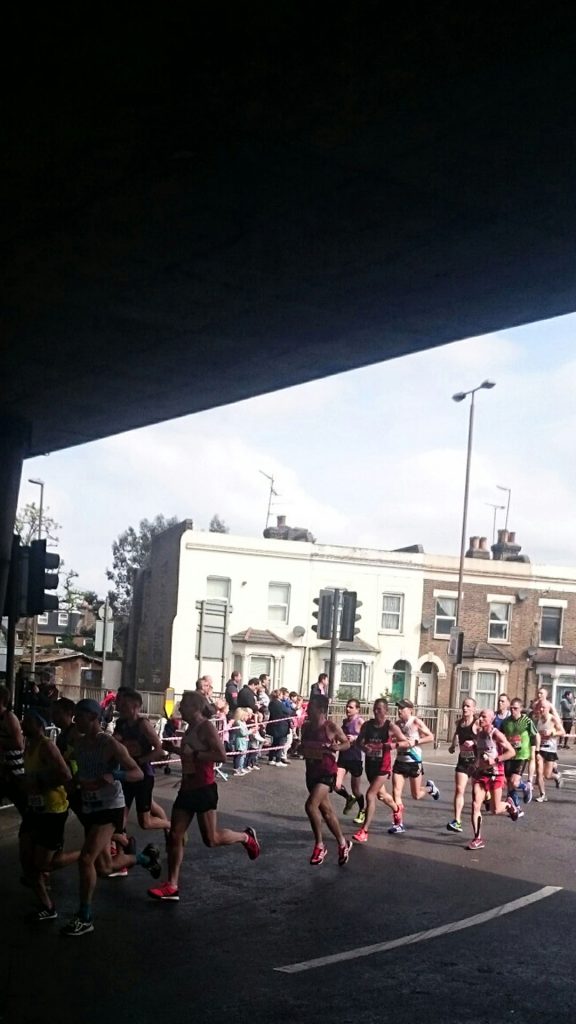
Picture c/o Robert McArdle.
The run from Woolwich to Greenwich was where it all began to fall apart last year, the early onset of cramps, or myofascial pain as I’ve been instructed to call it, slowly rendering me a walking, miserable mess by 21 miles. I was very concerned I was going to go the same way given the hip scare and the IT band discomfort, but for now I was running pain free, running quite quickly and it was feeling very comfortable. Mile 4 was 5:58, (5:57 in 2016), mile 5 was 6:06 (6:07 in 2016). The HR average for mile 4 was 159, pleasingly much lower than the maximum I give myself of 165 bpm. I did though notice near the end of the mile that my HR was showing well over 170 and at one point registering 183, which would be the highest I’ve seen it since a very hard 5k a couple of years ago. These weird readings continued in miles 5 and 6 – my theoretical max of 188 was all but reached in mile five and the sixth saw my heart go into overdrive – 210 BPM! It’s never been anywhere near that high and I assumed that either I was picking up someone else’s HR or something was amiss with the strap.
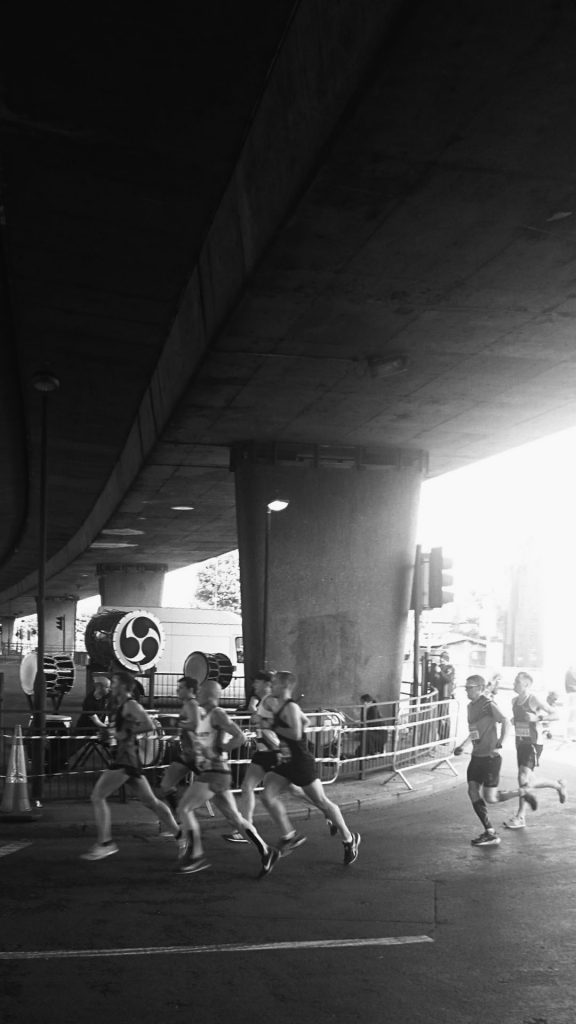
Picture c/o Robert McArdle.
It was annoying in one sense as I do like to run my marathons to HR. However I had established a pace and a perceived effort for at least one mile at (slightly less than) target HR, so could instead fall back on trying to stick to that pace and effort for the rest of the race. Somewhat old-school, it felt strangely liberating. I sporadically looked at my HR during the race. Sometimes it would look half realistic, then I’d look again and it would show something crazy like 215 BPM, It did this for the rest of the race. I assumed the strap had broken, but I’ve worn it a number of times since and had no issues – so I’ve no idea what caused this to happen.
Back to the race. Mile 6 was 6:04 (6:10 in 2016), the discrepancy in my Garmin mile splits and the real mile markers was up to 25 seconds. From past experience I knew this was going to happen and would grow over the course of the marathon. It’s not a big deal, just something to factor in when trying to calculate your likely finishing time on the fly. I passed the official 10k approaching the right turn at Greenwich in 38:19 – 19:03 for the second 5k. I was loving the enthusiasm of the crowds. Strangely though, as we passed the Cutty Sark and Greenwich itself, the crowds, although vast in quantity, were perhaps some of the quietest on the course. This suited me as it’s usually an area where it’s impossible to avoid an adrenaline surge.
I took my first of three gels at seven miles and with it the only the second water bottle of the race thus far. In every marathon since 2005 I’ve taken six gels, this year I decided to go with three, at 7, 14, and 20 miles. The reasoning was twofold – most of my long training runs are done without breakfast beforehand, let alone sustenance while running itself. Therefore I reckoned that six gels may be a bit excessive. Moreover I wondered if some of the gastro distress suffered in recent marathons may have been partly down to having to cope with digesting too many gels and the water that is needed to go with it. For the remainder of the race I pretty much stuck to taking on water at the mile where I’d taken a gel and the water station a mile later. With the weather not being particularly warm, this tactic seemed to work well. I was reasonably dehyrated at the finish, but not in a state that affected my performance.
The third 5km chunk of the race was fairly uneventful although I do remember a section with a small incline around a supermarket featuring some of the loudest crowds of the race as I coincidentally passed a runner who was walking dressed as a bricklayer. He had no number and clearly had never been running from the start of the race. Indeed en route during the race I must of seen a handful of runners who didn’t look as though they had been at the start line or spectators who appeared to be undressing in a manner that suggested they were about to take part in the race. I guess there is little that can be done to stop this. I found it more amusing than anything, a welcome distraction from worrying about how far there was to go. For the record, miles 7, 8 and 9 were 5:59, 6:03 and 6:03 (6:02, 6:08, 6:07 in 2016). I went through 15k in 19:01 – this would be the fastest proper 5k split of the race (I’ll explain why it might not be the fastest in a bit…).
The tenth mile is one of the quieter miles in terms of crowd support, but this year there was really no such thing as a quiet part of the course. It was where I caught up and eventually passed Joe Spraggins, who turned out to be the fastest of the numerous fancy dressed runners, finishing in 2:42:24. His attire was hardly restrictive however, dressed in little more than a pair of Speedos, a swim hat, goggles and snorkel. He certainly caught the attention of the crowd, who all knew his name thanks to Joe being scrawled on his bare chest!
The tenth mile split was in 6:09 (6:02 in 2016), 1:01:00 exactly on my watch for ten miles. I hadn’t yet clocked any indication as to what my final time may be, especially as the Garmin was around 40 seconds out on the official distance. More worryingly bang on 10 miles the right hip that had caused so much distress before the start of the race, now decided it was the right time to give some quite painful distress signals. Rather than massage the hip itself, I decided to prod firmly the same bit of tummy that I had done on the start line, which mercifully appeared to give some relief. I don’t know if what I was doing actually made any difference, but the pains seemed to subside whenever I did prod myself. So this I continued to do, with increasing regularity, for the remainder of the race.
Mentally that was a low point in the race. I knew that my wife, daughter, brother and his fiance, had planned to try and spectate somewhere around the 11 mile point. I gave serious consideration to dropping out when I spotted them, to save them the bother of trying to see me further along the course. Luckily at the moment when they saw me and I saw them, giving a quick wave as I passed, I wasn’t in pain so that thought quickly left my mind and it was back to hoping and waiting that the wheels wouldn’t fall off the wagon. Just after passing the family I caught long time former training partner and club mate Stuart Hopkins, who was hoping for a time similar to mine – as he has done at each of the last five or six marathons we have run in together. Sweating somewhat (he’d suffered a cold before the race) I felt cool in comparison as I greeted him on passing with the somewhat negative comment I’m waiting for my hip to give up on me as he wished me well for the rest of the race.
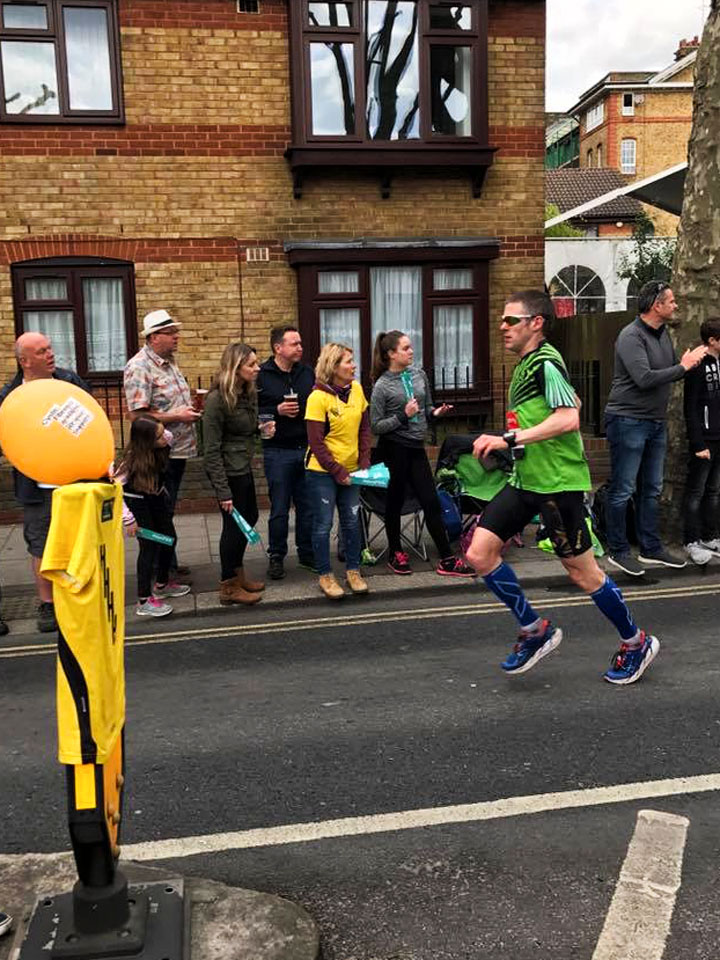
Pained or not, the hip wasn’t slowing me for mile 11 saw me speed up to 5:56 (6:03 in 2016) and mile 12 was a 6:04 (6:07 in 2016). I was still for the most part feeling comfortable as we turned right and took on the legendary Tower Bridge. Like Greenwich, this most famous of spectator vantage points didn’t seem to be quite as densely populated or as vociferous in it’s support than in previous years. I’m guessing that spectators are making use of the excellent official spectators guide to visit previously less well populated areas that are just as good if all you want to do is pick out your loved one.
The fourth 5k at 20km was 19:06, As we went over the other side of the bridge we soon passed 13 miles – 6:02 compared to 6:12 in 2016. For the first time I looked left at the bottom of the bridge and spotted the unmissable sight of the Tower of London, which I had managed to miss on each of my ten or so visits to the London Marathon. Barely any time had passed before another significant time check came – halfway. My watch read 1:20:30 as I hit the chip mats. This was pretty much spot on for what I could have hoped for – it gave me a sporting chance of a sub 2:40 with a negative split run, or a very good chance of a new PB – my best being 2:43:41 set at Chester in 2015.
The 14th mile is the section where one side of the road is heading out to the Isle of Dogs, the other side is heading back towards the finish at 21 miles. It’s where I usually get to see some of the lead ladies and this year was no exception, although Mary Keitany was long gone by the time I arrived. Given the opportunity to see runners twice it is now one of the the most popular places to spectate – with crowds five or six deep for the entire mile or so stretch. Two who always get there early to grab prime real estate on the 21 mile side of the road are Kenilworth Runners legends Pauline and Tom Dable. Although I’m no longer a member of that Green Army, they spotted my GRC club colours and shouted me on with enthusiasm that couldn’t help but spur me on. Pumped with adrenaline mile 14 was a 5:59, exactly the same split as in 2016 but feeling much more comfortable as I took on my second Powergel washed down with a good helping of water.
One reason for feeling more comfortable is that the 15th mile for, I think, 4 of my last 5 marathons, has been the spot where I’ve had to call in to one of the roadside portaloos for an emergency pit stop. I’m happy to report that this year, aside from the odd exhale of extra exhaust fumes there was no gastronomic distress. Whether this was down to the reduced gel intake or the switch to granola bars from soft cereal bars, I’m not sure, but I’m not complaining either way. This meant that mile 15 was comfortably faster than in 2016 – 5:54 compared to 7:20. That fastest mile of the race meant that 20 – 25 km was (if my maths is correct) the fastest of the race in 18:54.
Just into the sixteenth mile is where we head into an underpass for the first time in the race, bearing right and into the Isle of Dogs. It’s where the Garmin can go haywire (It did indeed lose satellite reception) and where the legs have failed me on numerous occasions in the past. Thankfully on both accounts I had a positive outcome – the Garmin lost no more accuracy than it already had (it was now up to around a minute out) and my legs, although still with hip aching, were feeling good, bouncy, and very comfortable, certainly better than in 2016, where the pace was comparable, but I felt terrible.
Mile 16 was a 6:04 (6:03 in 2016). Miles 17-19 – around the Isle of Dogs and Canary Wharf – used to be one of the loneliest points of the course. Nowadays the crowds are immense, intense, and with the sounds of the screams and cheers reverberating around the closely packed skyscraper walls, quite overwhelming at times. Holding it all together, blessing every minute where I didn’t come to a screeching halt, mile 17 was a 6:03, mile 18 was 6:07, and mile 19 was 6:04, compared to 6:03, 6:12, and 5:56 in 2016. It should be said though these splits should be taken with a little pinch of salt as GPS accuracy is, putting it mildly, not the best around this part of the world – the GPS trail on Google maps showing a very jagged path rather than the smooth, controlled lines I was able to hold.
One runner who could not say the same as we passed through Canary Wharf was a poor chap ahead who had begun staggering violently from one side of the road to the other, and as I closed in was clearly in some kind of delirious state, frothing profusely at the mouth and seemingly not in control of his body. One runner went into offer assistance – a noble act indeed – but one I decided that today wasn’t the right choice for me considering a PB was in the making. Instead I alerted marshals just a little way up the road that there was a runner in distress. As I turned round a few seconds later and saw the hi-viz angels running towards the afflicted runner, I felt comfortable that he was in safer hands than I would be able to offer.
With that drama out of the way I pressed on, leaving Canary Wharf. I went through 30km in 1:54:24, the 5k split being 19:07. Shortly after this split, with continued development work taking place there is a rather contrived section of the course in place where we climb up a ramp, past a hotel, I think, then down onto the A1261 looping out and back on a road closed to traffic and spectators. It was here two years ago I blew up and it was here last year where I began to really suffer. Thankfully this year, although the right hip was nagging, I passed through the 20th mile in 2:01:15, without slowing, even perhaps speeding up as the Garmin clocked a 5:56 (6:11 in 2016).
The old saying that I hold dear is a marathon is a 20 mile jog with a 10k race tagged on at the end. Part one of this had been successfully accomplished. Despite passing through 20 miles over a minute faster than I’d ever run before, I’d felt as though almost all those miles were done with little perceived effort. As I sank down my third and final Powergel I was looking forward to putting on the afterburners for the final 10K, hopefully cranking up the pace to a glorious sub-2:40 finish.
Alas, almost literally a matter of meters past 20 miles, both quads gave the ominous feelings of deep fatigue. I didn’t feel as if my pace was slowing much, but the effort to maintain the same pace was now a whole lot harder. It also felt like at any moment the legs would quit on me, as they did in 2016 in the the 21st mile, when I slowed dramatically to run a 6:56 mile. Mile 21 was a 6:11. Mile 22 was hard, but it was a case of digging in and taking heart that while I was struggling, I was passing plenty of runners who were suffering like I was last year and the year before that.
Clocking another 6:11 (It was 6:50 in 2016), the 23rd mile was the hardest of the race. It’s the mile where you have the runners on the other side of the road just starting the second half of the race to the deafening support of thousands of spectators packing both sides of the large road. On the way out the road felt perfectly flat; now the tiniest undulations felt like monster climbs to negotiate. I battled on, praying that I could keep going, bemused at the sight ahead of a giant banana apparently running at 2:41 pace. I passed him, keeping an eye out for Tom and Pauline, who I spotted, but who missed me. I wasn’t aware of them, but apparently I’d missed my family shouting my name a couple of miles back. It’s hardly surprising given the cacophony all around me – there’d been numerous shouts of Go On Matt! or Matthew! which I’d turned to acknowledge, only to realise it was for a Matt or Matthew behind me. So perhaps one of those shouts was for me and I mistakenly ignored it.
I made it through Mile 23 – it was the slowest mile thus far at 6:22, but compared to the 7:27 in 2016 it was a very successful six minutes of running. I knew that what lay ahead was perhaps the most dangerous bit of road for my failing legs – the curved descent just past Tower Hill station down onto Lower Thames Street. If there was ever a stretch of road that would overpower the quads into a painful submission it would be here – it was at this spot in 2016 that I succumbed to the inevitable – stopping, before being annoyingly urged by the crowd to keep on going, which I did, albeit very slowly.
As I began gingerly descending, fully concentrated on not succumbing to cramp, I heard over my left shoulder the loudest shouts of Go on Matt! I think I’ve ever heard. The crowds were dense and it was hard to make out all the faces, but I spotted the unmistakable figures of friends and long time work colleagues James Moy and James ‘Beaver’ Bearne. I gave them the proverbial thumbs up and carried on. Moysee certainly was making his marathon spectating debut. They were there primarily to cheer home another F1 friend Will Buxton, who was expecting to take over 5 hours to finish his first ever marathon. That they had made the effort to leave the pub to watch me pass renewed my vigour and determination to battle hard to the finish.
I made it down to the bottom of the ramp in one piece, passing through the 35km marker in 2:13:49 clocking a 19:26 5k. It’s not long after here you head under the dreaded long and lonely underpass where nothing exists except other suffering runners. It was here I decided that I’d take a bit of risk by attempting to push on through the discomfort. My rationale at the time was I reckoned that I if I could get another quick mile or two in the bag, even if I slowed horribly and clocked an 8 or 9 minute mile at the finish, I would still bag a sub 2:45 performance.
Exiting the underpass, spurred on by the crowds and loud music up the drag and onto the embankment, I drove on. Mile 24 I clocked at 6:07, and mile 25 approaching Big Ben at 6:16. They weren’t the fastest miles of the race but the fact I’d reversed the trend of slowing miles gave me a tremendous morale boost, especially as I had etched on my mind the same miles in 2016 took an agonising 8:59 and 8:26. I went through 40km in 2:33:24. The 35k to 40k split was the slowest of the race in 19:35, but I sensed that the bad patch I’d gone through was long gone, and with nearly 12 minutes in hand to run just over 2km, one of the key objectives of a sub-2:45 clocking was looking very likely.
Turning right onto Birdcage Walk I apparently missed my family cheering me once again. By now, although heavily fatigued, the adrenaline was pumping and I began a very long mile and a bit sprint to the finish. The rather excellent personalised stats on Runpix show that on the final 7.2k I passed 84 runners and was passed by just two. This is the dream runners dream of when racing a marathon, finishing strong, picking off runners and feeding off that to drive yourself on not necessarily faster and faster, but not getting slower and slower.
I passed the 800 meters to go banner and picked up the effort once more. There is no 26 mile marker on the course but my watch had clocked it some time earlier (it ended up registering 26.57 miles) as a 6:04 mile (It was 7:47 in 2016). Turning right passing Buckingham Palace it was a welcome sight to see the cones that they have out for the elite finishers still in place. Ushered into the middle lane I turned right into the Mall and saw the official clocking reading something like 2:41:00. Already running hard I summoned every last ounce of energy for the mother of all sprint finishers, According to the Strava segment I ran the last 385 yards in 56 seconds, which is 5:20 pace. I’d run the last 0.6 mile on my Garmin at 5:44 pace.
As I crossed the line I looked to the sky and thanked the running gods for seeing me to the finish line in one piece. I’d broken 2:42 on the official clock, and I knew that my chip time would be a few seconds faster. It was. My official time, already posted on the brilliant London Marathon app for all those who followed me to see, was 2:41:42! A new PB by as near as dammit two minutes! I pumped my fists and whooped in elation – something of a rarity for one who is usually fairly composed at the finish.
It was a good job I had my sunglasses on for I recall I got a little too emotional at the finish, not exactly blubbing away, but certainly the eyes got a little moist. The culmination of months, years of training, the stress at the start and the uncertainty whether I’d make it to the finish was a little overwhelming. Then reality kicked in. The legs, fueled on adrenaline to surge me nearly pain free to the finish, found themselves bereft of adrenaline and began to really hurt! Last year I found this pain utterly dejecting, this year I nothing was going to spoil my delight as I gratefully received my goodie bag and medal, posing for official photographs that I had no intention of purchasing as they are stupidly expensive.
Part 4 – The Aftermath
The first familiar face to greet me after the race was fellow club mate Rob McArdle. After the congratulations and very concise post race review, he took a post race picture to replace the one I wouldn’t purchase, and we spent a few minutes charting the progress of other GRC runners. Not long after leaving him and wearily collecting my kit bag, Stuart caught me up. He had run 2:50, not what he’d hoped for but highly commendable given his restricted preparations for the race. We chatted about the race, training, duathlons, as we wandered slowly and painfully to the K-L repatriation area, where I was enthusiastically greeted by my daughter, then my wife – who knew that this would be a more congenial afternoon than 12 months earlier.
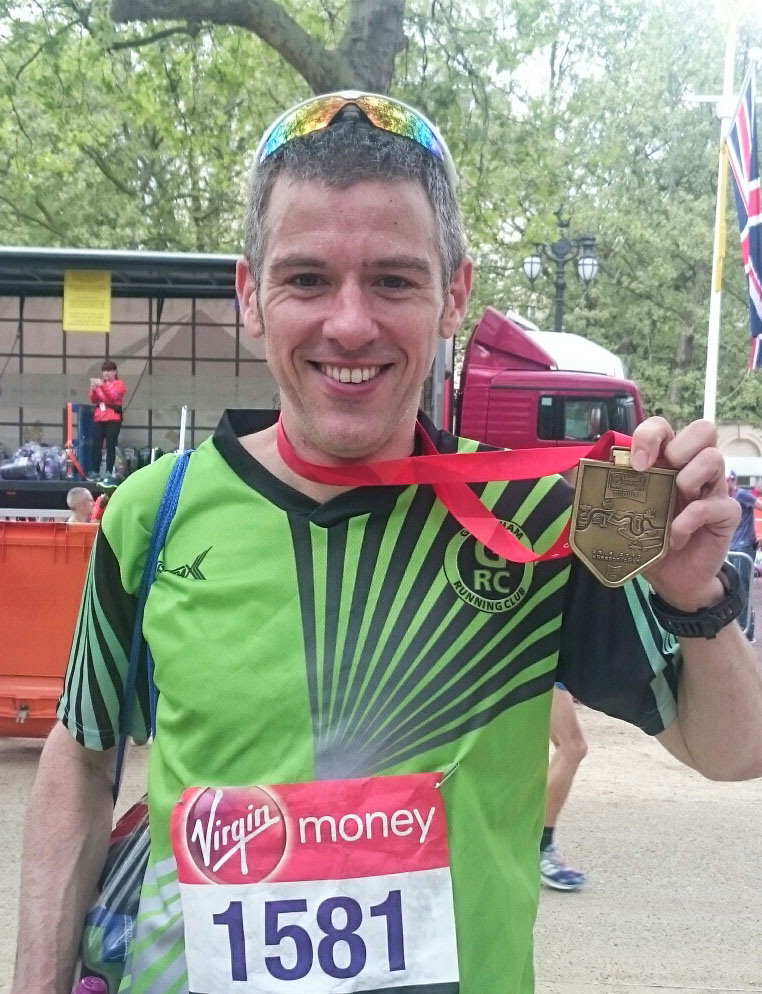
Picture c/o Robert McArdle.
Changing trainers proved nearly impossible, I had to call upon the services of my wife to assist. I didn’t bother with much else other than putting on my tracksuit bottoms. This meant that as we left the marathon building my medal and race number were on full view. This wasn’t a deliberate attempt to garner attention, but it is incredible how many people, even hours after the race would congratulate me on my efforts. It’s days like these when you are reminded that 99.9% of the world are good, decent folk – a shame then that it was sadly necessary for the security at the finish to be evidently ridiculously high – possibly one of most locked down places on the planet at that moment.
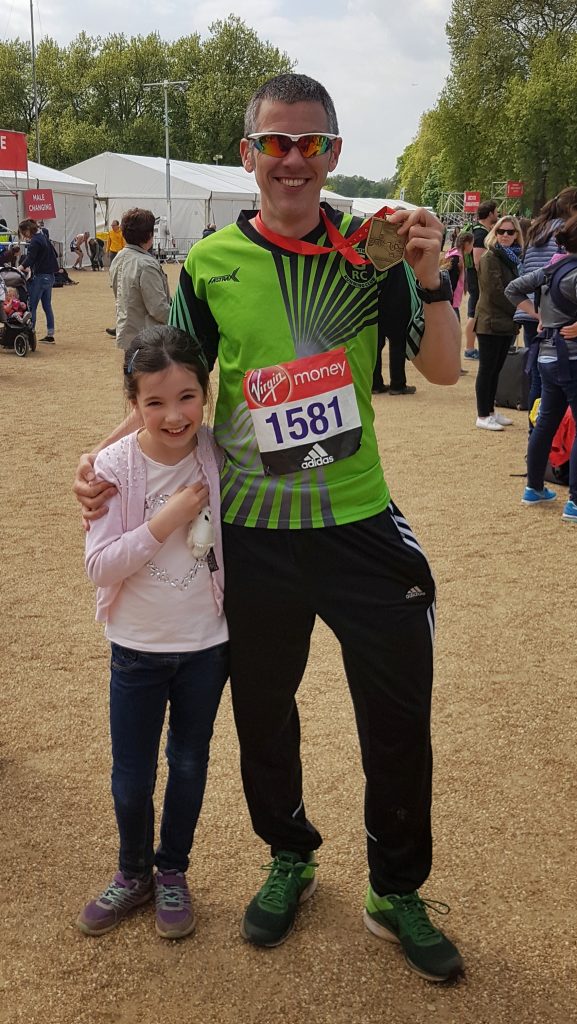
In previous years I have hung around the Covent Garden area after the race for a celebration / wake. This year I was calling on the local knowledge of my brother who, after we finally got on a tube train after some confusion at Charing Cross, took us to a pub in Chalk Farm, near where he and his fiance used to live. It was a bit of a trek and my weary legs didn’t thank him at first, but from the sight and smells of the giant roast dinners put in front of us it was well worth the walk. I though, as usual after a marathon, couldn’t stomach the thought of food, and was happy to have just a few chips from my daughters’ plate. I did patake in a welcome pint or two of cider as I caught up with the exploits of all the others I knew taking part in the marathon and replied to the numerous congratulatory messages on Facebook and Strava.
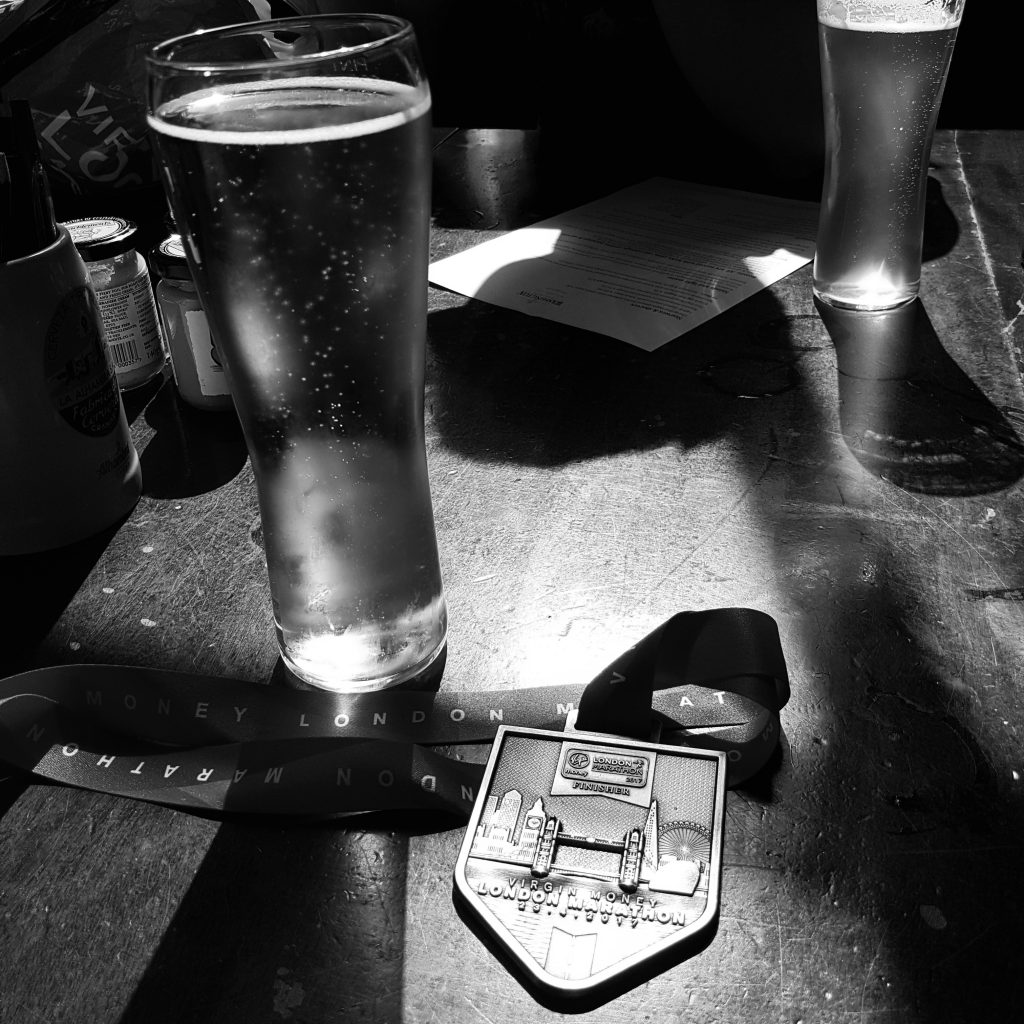
After the meal we walked down to Camden Town, taking in some stunning views of London en route at Primrose Hill – we could see most of the sights I had passed during the marathon a few hours earlier. A walk through Camden Town itself was a nostalgia trip from twenty years or more ago when I was a near weekly visitor to its market. The walk from Camden to Kings Cross nearly killed me and my daughter but in the long run I think the 3-4 miles walk did wonders to help ease the pain in the legs.
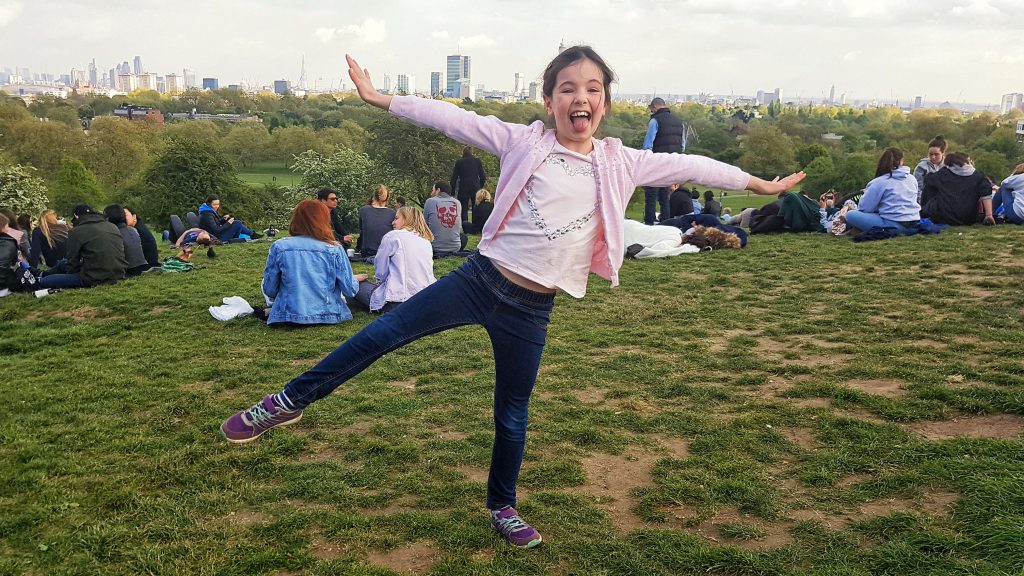
At Kings Cross we bid farewell to my brother and fiance and got on the first train to Stevenage, before my wife drove us home back to Grantham. Too tired to consider cooking and eating alone after my better half had basically eaten a whole chicken for lunch, I ordered a large Indian takeaway, my first in many many months. It tasted bloody good as we sat down to watch the recorded live coverage of the race. I made it to around 22 miles of the ladies race before I resigned myself to not being able to stay awake and headed to bed. All in all a most memorable day, a highly successful one. One that won’t be forgotten.
Stats:
